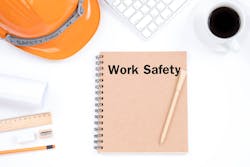When pulling cables through raceway in an operating facility, you run the risk of electric shock. If you have de-energized all circuits that you might come into contact with during the pull, can you still experience an electrical shock?
The answer is “yes.” The culprit isn’t an energized circuit — it’s an energized metallic object (or many such objects).
The danger exists because the metallic objects are not bonded together and there’s not a low-impedance path back to the source. To be low-impedance, the path must be metallic and have electrically sound, mechanically sound connections.
A ground rod on the load side is not a low-impedance path. A metal conductor that runs back to the service is. So is a set of metal conductors, such as properly connected EMT or properly connected IMC. Metallic tubing, metallic conduit, and metallic cable tray are all proper components of the equipment grounding conductor (EGC) [250.118], but you don’t have an ECG unless these components are connected to maintain electrical continuity.
About the Author

Mark Lamendola
Mark is an expert in maintenance management, having racked up an impressive track record during his time working in the field. He also has extensive knowledge of, and practical expertise with, the National Electrical Code (NEC). Through his consulting business, he provides articles and training materials on electrical topics, specializing in making difficult subjects easy to understand and focusing on the practical aspects of electrical work.
Prior to starting his own business, Mark served as the Technical Editor on EC&M for six years, worked three years in nuclear maintenance, six years as a contract project engineer/project manager, three years as a systems engineer, and three years in plant maintenance management.
Mark earned an AAS degree from Rock Valley College, a BSEET from Columbia Pacific University, and an MBA from Lake Erie College. He’s also completed several related certifications over the years and even was formerly licensed as a Master Electrician. He is a Senior Member of the IEEE and past Chairman of the Kansas City Chapters of both the IEEE and the IEEE Computer Society. Mark also served as the program director for, a board member of, and webmaster of, the Midwest Chapter of the 7x24 Exchange. He has also held memberships with the following organizations: NETA, NFPA, International Association of Webmasters, and Institute of Certified Professional Managers.
